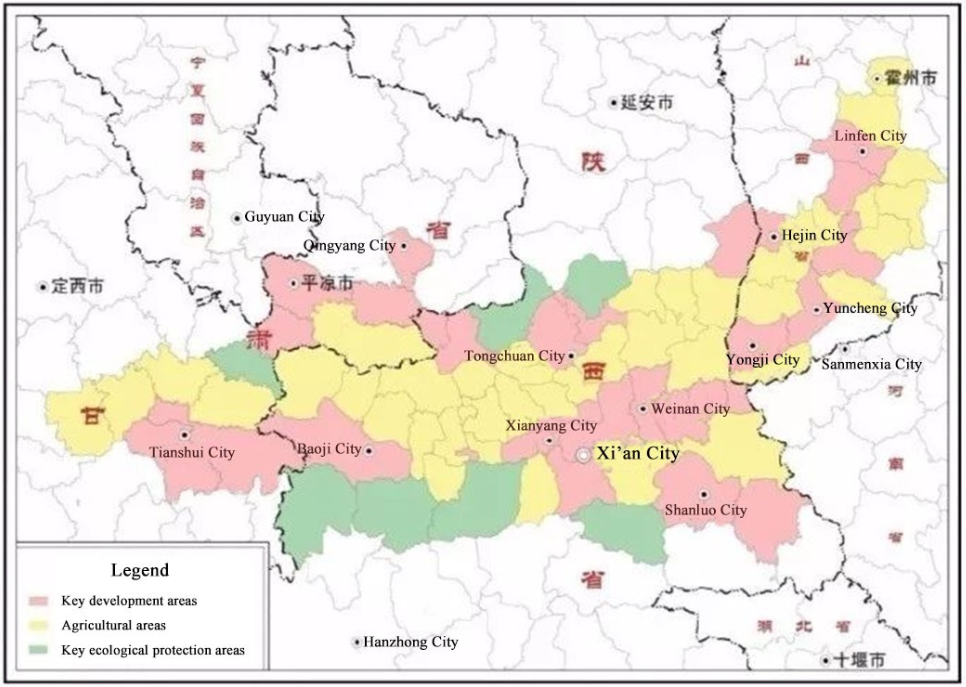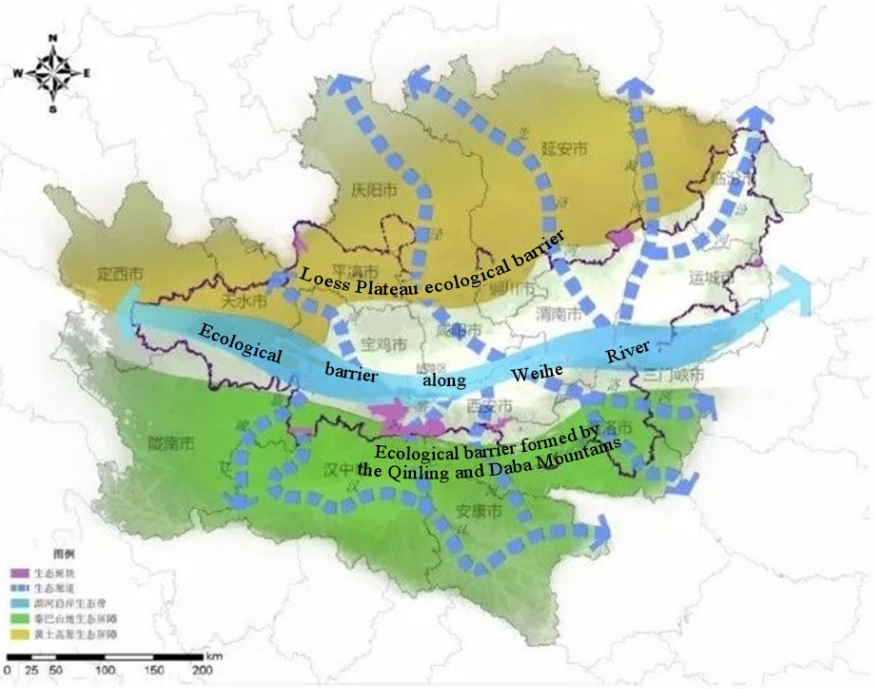Xi’an was designated as the ninth National Central City
On the afternoon of February 7, the National Development and Reform Commission (NDRC) published the Notice on Printing and Distributing the Development Plan of the Guanzhong Plain Urban Agglomeration on its official website, designating Xi’an was designated as a national central city.

Figure 1 Layout of the Guanzhong Plain Urban Agglomeration
LAYOUT: MULTIPLE AXES, MULTIPLE CLUSTERS, AND MULTIPLE CENTERS
Xi’an National Central City will have multiple axes, multiple clusters, and multiple centers. The layout of the Guanzhong Plain Urban Agglomeration is characterized by one ring, one axis and three zones. Xi’an City, Xianyang City and the Xixian New District together will form Xi’an metropolitan area.
↓↓↓
Multiple axes: Cultural, science, and international exchange axes running from north to south through the ancient capital Xi’an.
Multiple centers: Xi’an National Central City will have the following centers: downtown city of Xi’an, which will be developed into a cultural, tourism, modern services, and commercial center, host city for headquarters of large firms, and the core impression management area of Xi’an; a modern commercial and high-tech center, consisting of Fengdong New Area (technological functions) and Fengxi New Area (commercial functions); a new ecological and modern services eastern center in the east part of the city, including Chanba ecological zone where the Eurasian Forum is held annually, Silk Road International Convention and Exhibition Center, Xi’an International Trade & Logistics Center, and Xi’an Olympic Sports Center.
Multiple clusters: Xi’an National Central City will have ten new areas (including East New Area and High-tech New Area), ten districts (including Textile City Area, Military and Civilian Integration Valley), about 50 themed towns and 50 complexes.

Figure 2 Functional Zonation of the Guanzhong Plain Urban Agglomeration
POSITIONING: “THREE CENTERS, TWO VANGUARDS AND ONE HUB”
The positioning strategy of Xi’an National Central City can be summarized as “Three Centers, Two Highlands and One Hub”. More specifically, Xi’an City will become a historical and cultural metropolitan city that will serve as economic, international exchange, technological centers of Western China, vanguard in the implementation of cultural initiatives of the Silk Road and the inland economic opening strategy and national integrated transportation hub.
Western China’s economic center. Xi’an has become the only mega-city in the northwest region with the total economic output ranking the third in the western region. It has formed a modern industrial system featuring tourism, cultural industries, strategic emerging industries, advanced manufacturing and modern service industries. It is also a national manufacturing center for aerospace, IT and equipment manufacturing industries. Xi’an hosts a full range of modern service industries such as finance, logistics, commerce and trade and plays an increasing important role in promoting industrial development.
International exchange center. Xi’an has frequently engaged in international exchanges. It has established friendship with 31 foreign cities. There are 4 foreign consulates in Xi’an and 17 foreign visa centers. Xi’an is also the first city in the northwest to offer 72-hour visa-free stays for transit passengers from 51 countries. Furthermore, Xi’an is also the host city of the Eurasian Economic Forum, the Silk Road International Exposition and other international events.
Technological innovation center on the Silk Road. Xi’an ranks third in scientific and technological strength among Chinese cities with more than 3,000 scientific research and development institutions, 231 provincial and ministerial key laboratories, 231 engineering and technical research centers, 67 academicians of both academies and institutes, 800,000 professional technicians. The concentration of technological resources ranks first in the country. With 63 colleges and universities, 46 postgraduate training institutions, 189 secondary vocational schools, 1,200,000 students enrolled in higher education, more than 300,000 students graduating from higher education institution each year, and more than 20,000 students completing master’s and Ph.D. degree programs each year, Xi’an is one of the top ten innovative cities in China.
Vanguard in the implementation of cultural initiatives of the Silk Road. Xi’an is the cradle of Chinese civilization, a world renowned historical and cultural city and a starting point of the ancient Silk Road. Thirteen dynasties, including Zhou, Qin, Han and Tang, built their capital in this city. Six relics were selected for the World Cultural Heritage and are reputed as China’s Natural History Museum. The inclusive culture of the city created favorable conditions for international cooperation. Rich historical and cultural heritage makes Xi’an a unique, easily identifiable and inclusive city. It exerts considerable international influence.
Vanguard in the implementation of the inland economic opening strategy. Xi’an has well-established platforms to support the economic opening strategy, including Xi’an Comprehensive Bonded Zone, Xi’an High-tech Comprehensive Bonded Zone, Xi’an Export Product Processing Zone and Xi’an Airport Comprehensive Bonded Logistics Center and China (Shaanxi) Pilot Free Trade Zone. Xi’an Port is the first inland port in China that serves both international and domestic trade as originating port and destination port. It plays a crucial role in propelling the central and western regions to participate in global economic and trade activities.
National integrated transportation hub. Located in the geographical center of China and the junction of the two central and western economic regions, Xi’an is an important strategic hub on the Silk Road, linking Asia and Europe, the East and the West, the South and the North. Xi’an Xianyang International Airport is the second largest airport in northern China. Xi’an Railway Terminal is one of the six major national railway hubs. Xi’an North Railway Station is the largest railway station in Asia (18 stations and 34 lines). A “mi (米)”-shaped high-speed rail network allowing people from Xi’an to reach capitals of surrounding provinces within one day will be built. With a “mi (米)”-shaped high-speed rail network and a highway network consisting of one ring and twelve axes, Xi’an Highway Hub is one of the six major hubs of the national highway network.

Figure 3 Ecological Zones of the Guanzhong Plain Urban Agglomeration
KEY TASKS OF XI’AN NATIONAL CENTRAL CITY
1. Improving the layout of the city. Xi’an will strive to improve the functions of Yanliang, Lintong, Xingping and other peripheral clusters, promote the convergence of Xi’an and Xianyang, adjust administrative zonation according to procedures, protect the historical and cultural relics of the ancient capital, coordinate the development of the Old City and new districts, and speed up the construction of three-dimensional traffic system in the Greater Xi'an metropolitan area.
2. Increasing industrial support. Xi’an will build industrial clusters; speed up the construction of Xi’an High-tech National Innovation Demonstration Zone, Xi’an National Economic and Technological Development Zone and other platforms; build a demonstration zone for industrial transfer and seize the opportunities created by the Belt and Road Initiative and the transfer of processing industries from the eastern region; take advantage of the market size and abundant resources in the northwest; participate in the division of labor across the country and actively promote the development of automobile, equipment manufacturing, IT, biomedicine, food processing, textile and other industries; work with other cities to create an appropriately planned industrial transfer demonstration zone with Xi’an as the core.
3. Implementing the innovation-driven development strategy. Xi’an High-tech National Innovation Demonstration Zone will play a key role in promoting innovation and drive the development of Xixian, Baoji, Xianyang, Weinan, Yangling, Tianshui and other development zones.
4. Promoting in-depth military and civilian integration. Xi’an will seize the opportunity created by the comprehensive innovation pilot program; improve the industrial layout and implement the value chain innovation initiative; make overall efforts to promote the reform of military industrial and research mechanisms, speed up the transform of military and technological advantages to innovation and industrial advantages; establish multi-level coordination mechanisms and strengthen the coordination of strategic plans, tasks and policies for the integration of military and civilians; and create a demonstration zone for the integration of military and civilian industries.
5. Supporting service industries. It will serve as an integrated service center and gateway city for the northwest, and play a strategic role in maintaining the prosperity and stability of the northwest; seize the opportunity created by the designation of Xi’an as a national central city and regional hub, build a comprehensive transportation corridor to communicate with the major economic zones in the northwest, speed up the gathering of resources such as labor, capital and technology, accelerate the development of new driving forces and create national centers for advanced manufacturing, strategic emerging industries and modern service industries, and promote the development of the northwest and surrounding areas; fully utilize medical resources in Xi’an, promote medical associations and share high-quality medical resources; and encourage medical institutions to increase exchanges and cooperation through remote diagnosis and treatment, dispatching experts, personal exchanges, training, etc.
6. Improving the transportation network. Supported by Xi’an Xianyang International Airport, Xi’an North Passenger Transport Railway Station and Xi’an International Trade & Logistics Center, Xi’an City will accelerate its efforts to become an international integrated transportation hub on the Silk Road Economic Belt with greater spillover and agglomeration effects; create a high-speed information sharing network, accelerate the establishment of Internet infrastructure directly linked to the national Internet backbone, strive to become a next-generation Internet technology demonstration city, support the construction of China-Central Asia cross-border landline cables and provide comprehensive information services for the construction of the Silk Road Economic Belt; improve the functions of the national important data disaster recovery center in Xi’an and work with other cities to establish a joint data disaster recovery center.

Further Information
WHAT IS A NATIONAL CENTRAL CITY?
What is a national central city? National Central City is a concept proposed by the Ministry of Housing and Urban-Rural Development of China in the Plan of the National Urban System in 2005. The national central cities are described as a group of cities at the highest level of the national urban system in charge of leading, developing, and performing tasks in political, economic, cultural and international exchange aspects.
The national central cities serve as China’s integrated service centers, industrial clusters, logistics hubs, vanguards in the implementation of the economic opening strategy and cultural centers.
|
City |
Positioning |
|
Beijing |
China’s capital city, political center, cultural center, international exchange center, science and technology center, international metropolitan city |
|
Shanghai |
International economic, financial, trade and shipping center; international metropolitan city |
|
Tianjin |
Economic, shipping, trade and logistics center of Northern China; economic center of the Bohai Economic Rim; ecological city |
|
Guangzhou |
International historical and cultural city, China's important central city; international trade center; integrated transportation hub and gateway city; regional culture and education center |
|
Chongqing |
One of China’s important central cities; facilitator of the development strategy of Western China; economic center of the western part of Yangtze River Economic Belt; economic, financial, trade, logistics, science and shipping center in the upper reaches of the Yangtze River |
|
Chengdu |
Western China’s economic, science, cultural, and international exchange center; international metropolitan city; integrated transportation hub |
|
Wuhan |
China’s historical and cultural city; important central city in Central China; China’s key industrial, science and education center; key integrated transportation hub; national central city designated by the National Development and Reform Commission |
|
Zhenzhou |
China’s historical and cultural city; important central city in Central China; key integrated transportation hub; national central city designated by the National Development and Reform Commission |
List of Designated National Central Cities
According to the NDRC’s Guiding Opinions on Supporting Wuhan in Building a National Central City, a national central city refers to a modern, strategically located metropolitan area that plays a crucial role in the implementation of national strategies, regional development and international exchange and can represent China. The planning and development of a national central city in a region with rich resources, favorable environment and a sound economic system is an important starting point for promoting nationwide new-type urbanization and an important measure to improve the regional layout of the economic opening strategy.
Source: sxaily.com and cnwest.com


